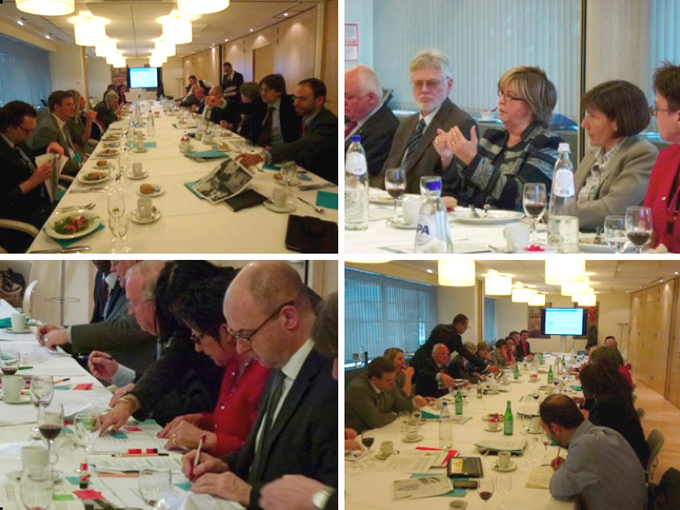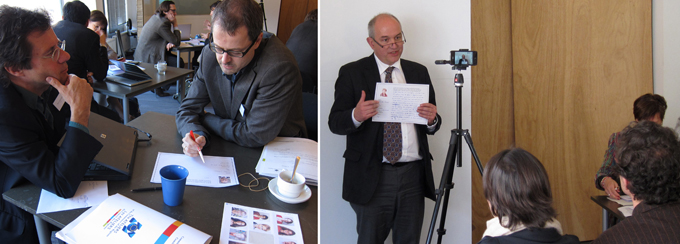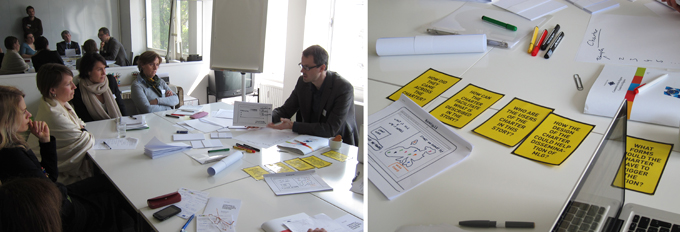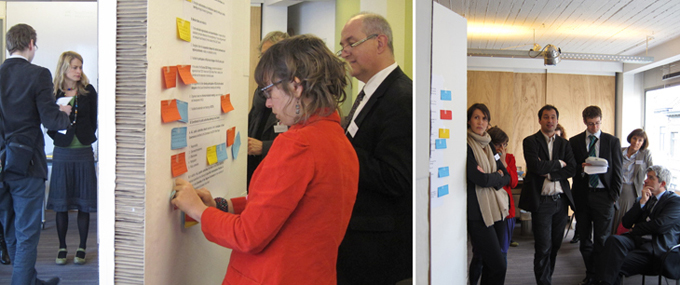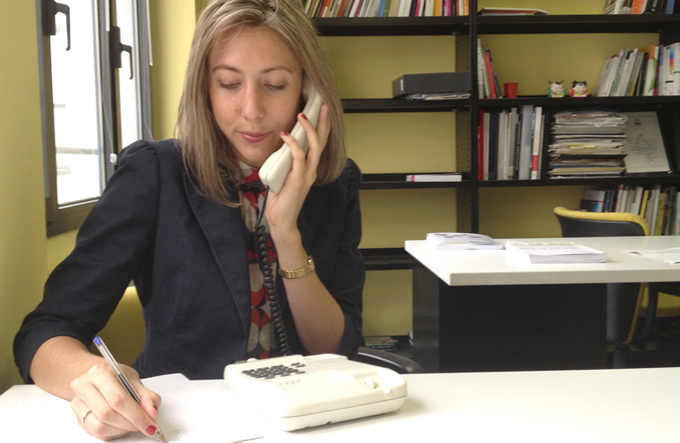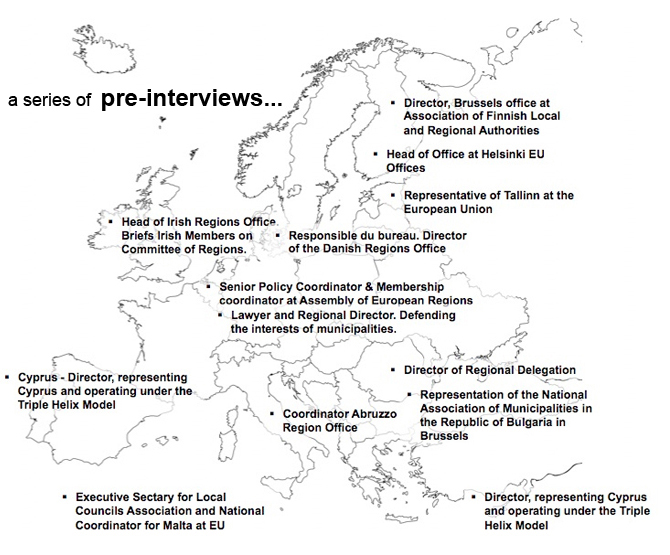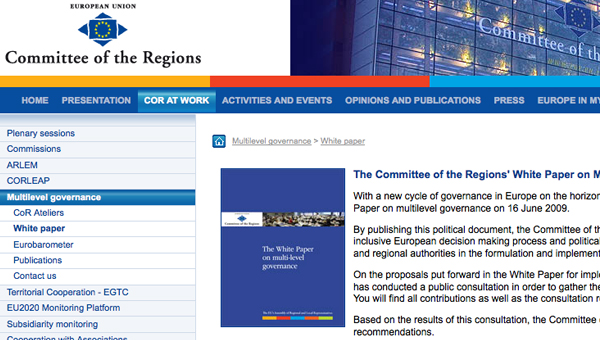Emerging requirements for the MLG Charter
At this stage of the co-design process the various interactions describe above with the different ranges of stakeholders brought 2 types of results:
- The first type of results achieved constitutes the orientations for the design of the Charter both in terms of content and form. These results forms the outline of the future MLG Charter in the form of a series of precise specifications that are presented illustrated with schemes and examples below;
- The second type of results is the convergence of views between the different stakeholders participating: at each main steps of the process so far – the simulation process by the steering Committee; the co-creation workshop; the feedback to the political groups in the occasion of the CIVEX – no particular divergence had to be noticed and participants themselves during the closing sessions mentioned they were sharing similar views.
These 2 types of results have been obtained thanks to the collaborative approach adopted so far: it helps to build at the same time converging and innovative views.
Lessons learnt from the story-telling exercises
One of the main part of the co-design process of the MLG Charter was based on a story-telling exercise: participants involved during the Steering Committee, the pre-interviews sessions and the Co-creation workshop were each time encouraged to imagine new situations where the MLG Charter would be used and to capture these situations though a simple Story-telling exercise.
Beyond working material for the use-based methodology, they constitutes a stimulating panorama of possible or potential usages and application of the MLG Charter. Different usages of the Charter are emerging form the analysis of the stories emerged from the story-telling exercise.
1/ Facilitating convergence and collaboration
The MLG Charter process is seen as a way for better mutual understanding and collaboration between institutional levels and various stakeholders, a space for exchange of experiences and practices, a basis to start negotiations, foster engagement and build coalitions:
- […] The process they are taking is also seen as learning and they share their progress on the MLG website […]
- […] idea is not only to create the communications between levels of government, but also bring this multi-layered communication and collaboration between academia, government and business […]
- […] The MLG Charter assists local, regional and national levels to adhere to national reform programs to implement various objectives set by Europe 2020 in local and regional areas […] Coordinators and facilitators who are familiar with the issue and MLG are working in cooperation with expert bodies and national agencies to ensure duplication does not occur […]
- […] The MLG Charter has been triggered to negotiate and collaborate with other European Countries to explore knowledge and methods to implement such a plan […]
- […] The Rescue Services […] are joining forces through leveraging the MLG Charter to work in partnership on both ambulance and fire emergencies […]
- […] local level […] needs to address the issues in their local context, however need to comply and work with national and international levels to monitor and measure progress. The MLG charter is assisting with the conversation, negotiation and facilitation going on between different levels […]
- […] regions are playing an increasing role in designing regional development strategy […]. MLG is being used as a charter to trigger for engagement […]
- […] I used it (the MLG Charter) in order to build a coalition with the representatives of the European Commission, the BCE 2, LRAS, to identify least painful and most just ways of applying the budgetary austerity needed […]
2/ Leveraging and taking action
The second usage of the Charter quoted in the stories collected is leveraging on the Charter to post complain or claim for governance changes and especially to facilitate dialogue between local/regional levels and national/European one:
- […] Along with my Ukrainian colleague, we have launched an appeal to the EU institutions based on the MLG Charter […]
- […] I’m reclaiming a “one-stop-shop” and I lodged a complaint to the mediator on the bases of the MLG charter […]
- […] although it is not their role, the group of cities decides to take action anyway and leveraging on the recently issued charter on multi-level governance […]
- […] start negotiations with the European Commission by leveraging with the Multi Level Governance Charter […]
- […] regions in Europe are cooperating with decision-making levels of government. In general the EU Commission and Member States are paying more attention to conversation and negotiation due to the new MLG Charter […]
- […] the City […] became one of the members of the European collective signatories of the MLG charter. Local partners now have a new form of leverage to claim their rights […]
- […] My lawyer appeals on the grounds of the MLG Charter which stipulates that the citizens cannot suffer the damage deriving from conflicts between regulations from different levels. So the suspension of the works has been upheld until the final resolution of the conflicts between regulations […]
3/ Inspiring model and reference
Also in many situations pictured in the stories, the Charter is seen as an inspiring element that ’embodies’ the change form the current models towards a new culture of governance and provide related processes and tools to support and promote it:
- […] be an initial source of inspiration for a full implication of all stakeholders […] guide consultation processes, […] identify tools and options, […] provide stimuli for experimentation and brainstorming and […] form the basis of the participatory process […]
- […] I discovered the Charter as an important reference with good and bad practices of democratic citizenship (from the online platform) […]
- […] a foresight exercise which will enable to anticipate the implementation and the actualization of the multi-level governance charter principles in a 30 years […]
- […] the “City” and townships don’t coordinate their politics, […] She used the charter […] to hold the tourist stakeholders “Accountable” via the local press. She progressively succeeded and got the mayors of the little townships to also sign the charter and the mayor […] to take concrete actions […]
- […] we used it to develop a 3D digital tool which allows to visualize data, stakeholders, competences of the different territories, public and private actors concerned at the various levels […]
- […] We went to see the municipal authorities, the hospitals, the organizations of nurses and doctors as well as the Ministries […] In other words, we helped MLG happen through our members […]
- […] Through the MLG Charters guidelines on how to create a culture of civil participation and co-designing public policies, they catalysed a new dynamic and culture change between citizens and local government. […]
4/ A multi-service of training, education, dissemination
Beyond the core content of GMN principle the Charter is seen as a system of elements (training programmes, implementation tools, education supports, etc.) to facilitate the dissemination of multilevel governance:
- […] The association has been using the MLG Charter Toolkits to make the animation of work session in which citizens have been able to express their design ideas and views […]
- […] The MLG facilitator has been mediating a conversation between the local and national levels to innovate ways to make best use of the current resources and capabilities […]
- […] MLG Charter assists the cohesion policy to be implemented effectively because of the training programs, tools, communications and education […]
- […] MLG Charter is the beginning of the process of instilling a culture of collaboration, so the education program helps to enhance the MLG agenda […]
- […] celebrate and create unity amongst EU members on MLG Charter; local, regional and national leaders come together for a 2 day forum to be trained on the principles of MLG and also sign the Charter[…]
- […] Decisions are in fact taking less time because there is a strong dialogue between different members. These members have been trained in MLG curriculum […]
- […] the MLG Charter has been utilised to ensure there is a 40% allocation of funds to the five regions […]. This transition will occur by having training programs set up with in the […] government to ensure there is strong dialogue occurring between local, regional and national governments on how the budget is being spent […]
- […] Children in local schools […] have been introduced to the MLG charter through the interactive charters website explaining in simple schemes and using easy examples, the main principles of MLG […]
- […] I could gain visibility towards the European Commission for my small association and its objectives. […]
- […] the city mayor which received the label “For a good MLG in Europe” by signing the charter have based some new local […]
MLG Charter presented during a CIVEX side session
A side session presentation to the political groups of the Committees of the Regions has been organized on the 27th of April in the occasion of the CIVEX annual meeting.
A first synthesis of the lessons learnt after the pre-interviews and co-creation workshop was presented through a series of slides to a series of representative of the political groups of the Committees of the Regions in the occasion of the CIVEX annual meeting.
The sessions took place during lunch time. It was chaired by Mr Luc Van den Brande in présence of the President Mrs Mercedes Bresso.
After the presentation of the collaborative approach and the general orientations for the MLG Charter, the participants had the chance to comment both the process and the early findings. They confirm the usage-oriented approach and underlined the necessity to keep the Charter concrete, simple so that people can easily understand it. The Charter should be design to prompt collaboration between the levels and capability to work together. They agree addressing the national level was key. They also encourage to use the potential of new media to enable the usages, dissemination and appropriation of the Charter.
Between main course and dessert, participants ware also involved to take part to a short hands-on tagging exercise commenting individually with stickers the main orientations for the Charter form and content summarized on table sets.
Synthesis from pre-interviews questions
The pre-interviews were meant to be short preparatory interviews to orient and facilitate the next step of Co-creation workshop. The first objective was to invite the respondent to the story-telling exercise.
Main lessons learn from the introductory and concluding questions could be summarized as such:
Questions focusing the MLG Charter were mostly answered in a broader sense of multilevel governance in general. MLG experts and non-experts emerging vision/description of MLG insists on:
- Dialogue and integration
“integration of government process”, fostering “a conversation and negotiation going on between levels”; “a stronger dialogue between regional and national level”; - MLG as reference and background for this dialogue
“setting basic rules concerning the form of cooperation”, “defining roles and the way in which each of the levels of government cooperate”; - Empowerment of local stakeholders
“encourage local indigenous authorities”, “make governance effective at local and regional levels”, “empower citizens and cities to take action” and “ensure decisions are taken by those who are most affected by the decisions”; - National level adhesion as key issue for effective MLG
“too much national level decision making power” and the necessity to “decentralize public services” and “reduce the level of control on issues that do not need centralized control”; - Involvement of all actor beyond public authorities
MLG is compared to “Tripe Helix […] where there is multi-layered communication between players in the government as well as business and academia”; - MLG is a political framework and new political culture
MLG represents “an administrative reform” that “should be instilled in the governance culture”.
The visions focusing more specifically the MLG Charter itself insists on:
- the adhesion to the Charter as a transposition of MLG into the local context. The Charter being a “step-by-step plan of action for regional and local authorities”; national and European politics being through the Charter “translated into down to earth, day-to-day operations”;
- the Charter as a collection of good examples as “a demonstration […] to create policy efficiency and effectiveness” and use “scarce public resources without duplication”;
- a training to MLG as part of the Charter services, the need to “train politicians on the MLG approach”;
- the necessity of a broad and general adoption by all actors: “It will be useless for Committee of Regions to have a Charter that is not agreed on by all levels of government: local, regional and national”. European level must show it’s involvement and the “Commission must sign it too”;
- the possibility of considering the good MLG practices recognition mark for the local authorities either as a ‘MLG label’ given at the adoption of the Charter or as a ‘MLG Award’ given after the entity demonstrates effective changes toward MLG in its governance.
- setting a monitoring process and “maintain the Subsidiary Monitoring Network”;
- the adoption of the Charter engaging effectively the parties, being “a legally binding document”. “If a country is accepting a charter it has to be a force of law. It can’t just slide”;
- the Charter as the first step of a process ensuring “there is a follow-up when the formal document is signed”. The “charter is a ‘wish’ once a charter is effective people have to respect it. (They) are a part of ‘a club’”.
It is to be noted that the general confusion between the roles/objectives of the MLG Charter with roles/objectives of the Multilevel Governance must be considered carefully: on the one hand, the MLG Charter seems to be very well perceived as integrated as part of the challenges raised by Multilevel Governance and, on the other hand, it reveals that the MLG Charter in itself is not very well identified as a specific instrument with clear identity and goals.
Co-creation workshop
A one day co-creation workshop was held on the 16th of April 2012 at SDS offices in Brussels and gather a range of 19 varied European experts focussing from different points of view the questions of Multilevel Governance and Charter definition.
Participants were involved into 3 successive design exercises regarding respectively usages, forms and content of the Multilevel Governance Charter:
- in pairs they imagine new situations of usage of the MLG Charter and capture them in short written stories they share in plenary;
- in 4 subgroups, they choose one or more of the previously built stories and mock-up with rapid paper prototyping technique the form they assume the MLG Charter should have to better enable story(ies) they focused. They presents to another subgroup their work and respectively assess if and how the proposed design of the MLG Charter would effectively facilitate the use, appropriation, dissemination, etc. of Multilevel Governance Charter in the situation their start from;
- finally, a Flying Wall was installed in the centre of the main meeting room and a proposal for the core content of the MLG Charter drafted by the Committee of the Regions was hung as an improvised exhibition. Participant provided with 3 types of coloured stickers were encouraged to tag the content draft with what they agree with, disagree with and what they suggests. This tagging process done contemporaneously by all participants starts exchanges in informal subgroups first and then a general discussion allow to wrap-up the lessons learn during the day.
This series of exercises hold in this order allows not only enriching the catalogue of situations of use imagined for the MLG Charter and the correspondent ideas of online and offline forms able to support and prompt these situations, but it allows also to change the participants perspectives on the content of the Charter.
As one of the participants very clearly summarized: “[…] the very fact of starting by building scenarios of use and envision possible material forms the new Charter could assume, changed completely my approach to the content.” Experts, that otherwise would tend to refine and detailed Multilevel Governance in the content, recommend to keep it short, accessible and explicit.
Pre-interviews with regions’ representatives
In order to prepare the next step of the Co-creation workshop, a series of short interviews have been conducted asking civil servants from the European regions representations in Brussels for 15-20 minutes of their time on the phone to take part to the co-design of the Multilevel Governance Charter.
The following map shows the distribution of the interviews conducted mainly across European regions’ representation but also including representatives from the Assembly of the Regions.
–
Map of the pre-interviews on the Multilevel Governance Charter with regions’ representatives in Brussels.
–
Main focus of the pre-interviews was to ask participants to take part to a story-telling exercise, which is to say to invent a potential situation of application of the Multilevel Governance Charter and tell in a short 10 lines story why and how the Charter was used and useful in this situation.
The interview semi-directive guide for the pre-interviews was larger than the core Story-telling process and investigated the respondent position and his/her vision about Multilevel Governance key principles, objectives of the Charter, co-signatories, recipients and users, monitoring and compliance processes, involvement and diffusion supports and personal commitment regarding the promotion of the charter.
Most of the 13 participants to the pre-interviews process were not experts of the Multilevel Governance or feel not comfortable enough in short interviews on the phone to develop on these more expert-oriented questions. But they all generated creative stories that are presented in this Blog and which has been analysed to enrich the collaborative process.
Collection of scenarios of use of the Charter
The core of the co-design process of the MLG Charter is based on a story-telling exercise: participants involved during the Steering Committee, the Pre-interviews sessions and the Co-creation workshop were each time encouraged to imagine new situations where the MLG Charter would be used and to capture these situations though a simple Story-telling exercise.
The catalogue of consistent 27 stories already constituted can be browsed hereafter. Beyond working material for the use-based methodology, they constitutes a stimulating panorama of possible or potential usages and application of the MLG Charter.
Click here to see all the scenarios >>>
Simulation of the collaborative process
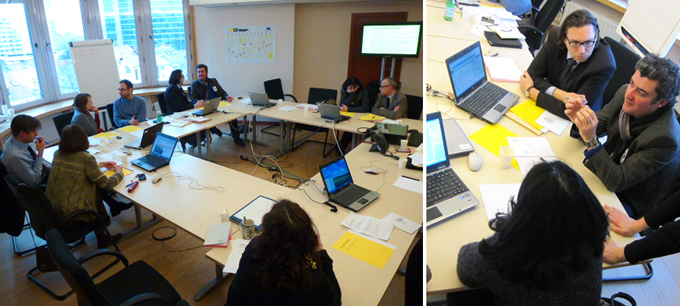
A collaborative emulation process…
For the first meeting of the Steering Committee organised at the Committee of Regions (Brussels) the 3rd of February 2012, a half day workshop was organised to experiment and discuss a proposed process of co-construction of the Charter. The purpose of this emulation workshop was not to complete a 4 month study in 4 hours but to try the main processes and tools, to test what works and what works less. In turn, to get an idea of the results at each steps. Emulation is intended here both as simulation (members of the Steering Committee are not exactly representative of the stakeholders mentioned above but they know them enough to emulate their participation) and as stimulation (a Steering Committee is better enabled to steer, improve, enrich the proposed process if it has experimented it by itself).
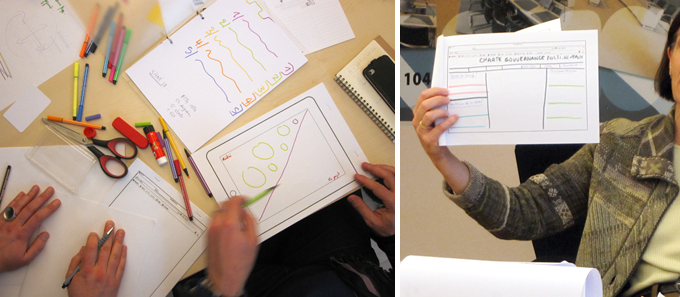
Emerging issues from experimentation…
The nine participants of the Steering Committee plus Strategic Design Scenarios team worked together envisioning the situation of the use of the Charter through story-telling. They tested and discussed the blog tools where the story of the co-design process will be shared online over-time. The wiki tool has been set for an easy and converging co-writing process. They mocked-up possible form factors of the Charter and tested these in subgroups to discover whether their respective designs is explicit and efficient. Finally they explore and discuss creative way to support promotion, dissemination and implementation of the Charter.
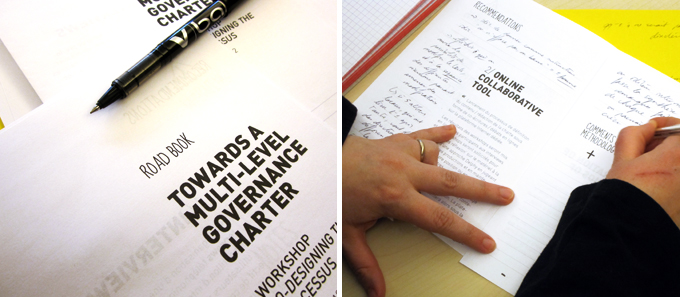
What are the lessons learned from this exercise?
The story-telling process pictured people – citizens, civil servants, responsible of public institutions, etc – leveraging on a multilevel governance Charter (MLG) to fluidify collaboration between neighbour regions or to simplify administrative procedure for citizens (have a look at the written stories here >>>). But participants gave for granted that these people know that such a charter exists and that they are aware of its content, what is far from being the case. From designing a Charter, participants rapidly acknowledged that key points were to activate multilevel governance as an issue for people and institutions: to give visibility to it, to make its content accessible and attractive, to make sure that one can leverage on it to take action. The tentative mock-up of the Charter revealed the need for a multi-dimensional object: beyond the core text, appropriation of multilevel governance requires visual case-stories on a website, a panorama of short interviews depicting points of views; a label highlighting promising practices and showing their increasing number all other Europe; the very result of the story-telling exercise that showing a range of application of the Charter, suggests explicitly how to use it; examples that works as a demonstrator to show that multilevel governance works beyond how it works; also failed practices that teach as well as good practices or event better;
The process also allows collecting a whole range of interesting issues to be further investigated such as: how do you enable users of the charter to browse the values behind the synthetic text? How can we enlarge the focus from institutions and professionals to citizens and schools embedding these governance value in primary education? How can we make a vivid and evolving charter when by essence a charter is static?
About the collaborative process
The missions of the Committee of the Regions
The Committee of the Regions is the EU’s assembly of regional and local representatives. Its mission is to involve regional and local authorities in the European decision-making process and thus to encourage greater participation from citizens.
Its political action is based on the belief that cooperation between the European, national, regional and local levels is essential if we are to build an ever closer and more mutually supportive union among the peoples of Europe and respond to the challenges of globalisation.
To this end, the Committee of the Regions works closely together with the European Commission, the European Parliament and the Council of the European Union, and in the Member States with the various tiers of authority, in order also to promote multilevel governance.
Multilevel governance: a political priority for the Committee of the Regions
To achieve this goal, the Committee of the Regions harnesses the potential of the Treaty of Lisbon, which enshrines the EU’s territorial dimension and confers new powers on the Committee. The CoR also builds on the recommendations made in the White Paper on Multilevel Governance, which it adopted in June 2009.
Following the adoption of the White Paper and the publication of the related consultation report, an initial step has been taken to promote greater account being taken of multilevel governance in the workings of the European Union, in the form of an annual scoreboard measuring the degree to which the EU institutions take account of the principles and mechanisms of multilevel governance when drafting, implementing and evaluating major European strategies and policies.
This action has been supported by the public consultation launched by the Committee of the Regions and the political initiative advocated by the White Paper to “initiate a consultation process with a view to drawing up a European Union Charter on multilevel governance”.
The results of the public consultation on the White Paper on Multilevel Governance have endorsed the CoR’s project to incorporate a common and shared understanding of European governance into the values underpinning the European Union.
This process can take the lead from a number of exploratory discussions that have been held, in particular at a workshop on The Elaboration of a European Charter on Multilevel Governance (MLG), held in Brussels on 22 June 2010, which brought together a number of experts, in particular academics and representatives of the Council of Europe. An initial academic discussion took place on the overall objectives, contents and implementing arrangements of a prospective European Charter on MLG.
This Charter should take the form of a real charter for the 21st century and whose drafting, implementation and follow-up should be as inclusive, transparent and open as possible for all tiers of government and the public.
This non-binding Charter is designed to provide an incentive, leading to genuine participation by local and regional authorities and the European public in exercising European democracy and to a common and shared understanding of European governance. It should also help emphasise the vitality and diversity of European regionalism and its role in the smooth functioning of our democracies and the contribution that can be made by active citizenship. In this process, consideration should be given to the lessons that can be drawn from existing charters and reference texts, especially the Council of Europe’s European Charter of Local Self-Government.
An approach based on usage…
On the basis of a call for tender set-up in Autumn 2011, the Committee of Regions retained Strategic Design Scenarios (SDS), a sustainability innovation lab based in Brussels and specializing in co-design processes, scenarios of use and definition of new product-service-policy systems to support them in the process of collaborative elaboration of the European Charter. A key point of the approach proposed by SDS is to focus on usage: beyond the synthetic written content, a Charter is a political object that addresses a variety of users: local and national elected people; civil servants from local public institutions, academic researchers and experts of governance, lawyers, journalists, citizens… Each of these profiles of people makes for different usage of a Charter and the form of the object Charter should support these multiple usages, facilitate them and diffuse them across levels and between institutions. It should also inspire new applications of multilevel governance, derive creative practices on the field and support a vivid and evolving dialogue between stakeholders…
A collaborative emulation process…
The approach and methodological process to produce the multilevel governance Charter is designed to correspond to the multilevel governance, to both inspire and be inspired by its very principles. In particular the approach is collaborative, engaging a dialogue with representative from the different levels, from local to regional and national authorities to the European institutions, trying to involve as much as possible a variety of stakeholders with enough European coverage. The approach is intended to be also participative, using workshop, online and offline co-creation tools, involving participants to both co-produce the new Charter and write collaboratively its content. Experimentation is also an issue in the perspective of multilevel governance in order to test the effect of a public action before implementing it. And so it is for the approach proposed to build the Charter.
Towards a Multi-level Governance Charter
With its White Paper on Multilevel Governance[1], the Committee of the Regions pledged to consolidate the values and principles of this mode of governance within European and national institutional and political frameworks. It especially committed itself to the far reaching objective of drafting a European Union Charter for Multilevel Governance, which should lead to greater participation by local and regional authorities in the exercise of European democracy[2].
Following this approach, the CoR decided to initiate an inclusive and participative drafting process, entrusting its external consultant, Strategic Design Scenarios (SDS) with the launching of a large consultation and interactive reflection process, which should lead by mid-2012 to the production of a first Multilevel Governance Charter prototype.
This website is dedicated to this collaborative process launched in February 2012.
